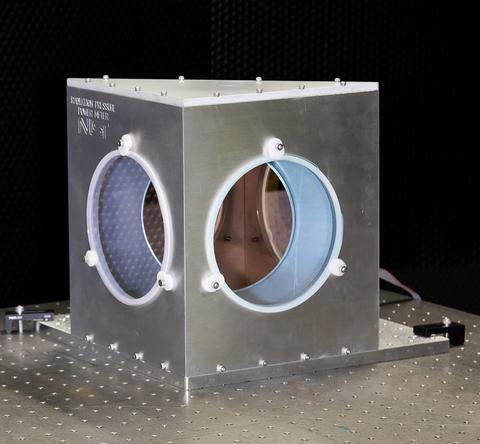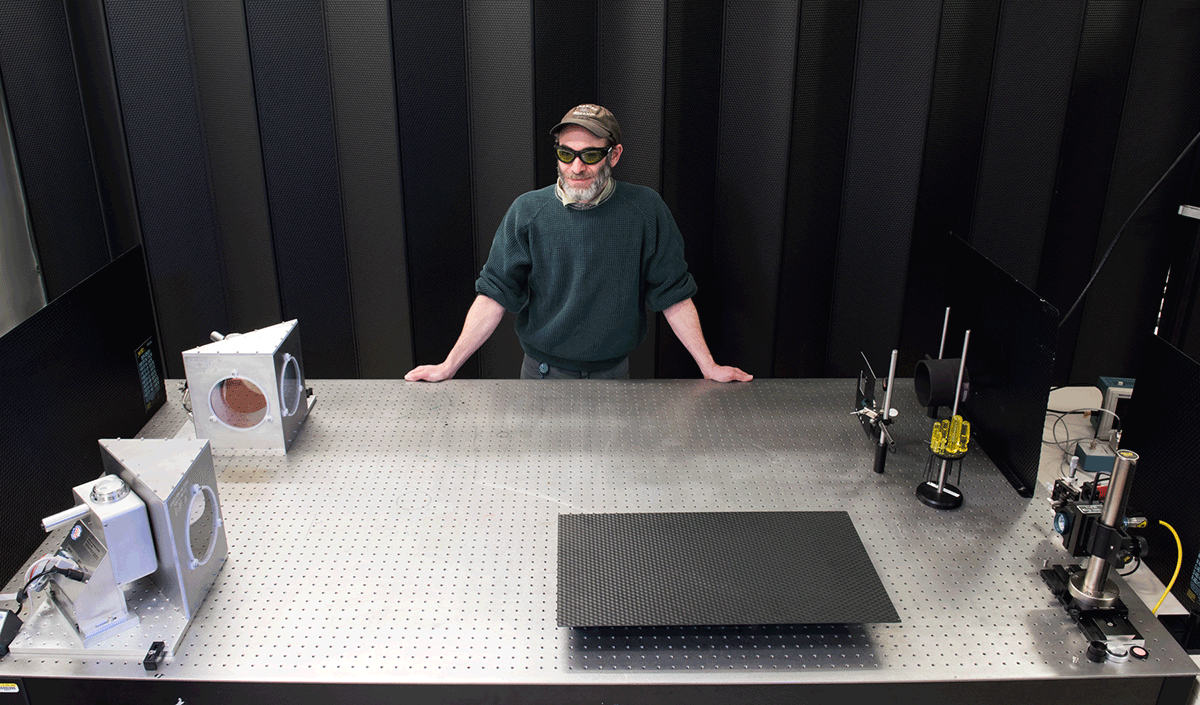Success Story: Measuring the Power of Laser Beams
As high-power lasers have become integral to numerous aspects of manufacturing, defense and more, the need to accurately measure their power is increasingly critical.
The NIST on a Chip program has addressed that need by inventing two similar patented technologies: the Radiation Pressure Power Meter (RPPM) and the Smart Mirror. Both are based on the force that a laser beam exerts on a mirror as the light is reflected off at an angle. Because the devices do not disturb the beam as its power is measured, they provide a way to precisely quantify laser power without interrupting manufacturing or other processes.
The force on the mirrors comes from the momentum of the photons making up the laser beam, called radiation pressure. The more power in the beam, the harder the photons push on the mirror. The force can be measured by a scale somewhat like those used in a chemistry laboratory.
Currently, the RPPM can accurately measure laser powers from 1 kilowatt (kW) to hundreds of kW, with its lowest uncertainty at the highest powers. (A beam of about 1 kW can cut through a centimeter of steel.) Applications requiring these power levels are laser welding and cutting, thermal testing of materials, laser weapons and more.
The highly sensitive Smart Mirror is designed to measure much smaller powers (25 W to 400 W) and to do so about 25 times faster than the RPPM. In addition to a weak spring-mounted mirror plate, it has a second parallel and nearly identical plate mounted next to the first. The separation of the two plates becomes a measure of the radiation pressure applied to the mirror plate with the added advantage of passively mitigating environmental noise that can arise from air currents or vibrations.
The Smart Mirror is suited to measuring beam strength in laser welding and additive manufacturing (3D printing) applications.
Measuring the Strength of Laser Weapons
Lasers have grown enormously powerful and are becoming a part of the U.S. military arsenal, destined to play a greater role in the future. But power outputs large enough for weapons used by the Navy, Army and Air Force have been increasingly difficult to measure by conventional means.

For the Navy, NIST recently used the RPPM to measure laser power up to 140 kW (average power) with 1% uncertainty. No upper power limit has yet been encountered, according to Paul Williams, who heads NIST’s Photoforce Project and co-developed the RPPM instrument.
That makes the RPPM well suited to the U.S. armed forces’ growing roster of laser weapons. In the fall of 2022, the U.S. Army took possession of an experimental 300 kW laser. “And the military is already planning for a 500 kW laser and then a megawatt,” said Tam Vo of the Naval Surface Warfare Center Corona Division (NSWC COR).
After a long collaboration in which the NSWC COR worked with RPPMs provided by NIST, in 2022-23 the NSWC COR established its own capacity to make RPPM units for the Navy and other services using the specifications and recommended materials supplied by NIST.
NIST Contributions
NIST researchers Williams, John Lehman, Josh Hadler, Aly Artusio-Glimpse, Brian Simonds, Kyle Rogers and other colleagues, as well as collaborators outside of NIST, have been investigating the design of a radiation pressure power meter since 2012.
“We originally developed the technology at NIST with our own funding,” Williams said. “But early on we talked to the Navy and found they were interested.”
“When I first heard about their concept, I said ‘If this works, it will be a game changer!’” said Dan King of NSWC COR. In 2013, the Navy began providing funding, and “we have developed a strong partnership with NIST over the years,” King said. “Now we have achieved the goal of tech transfer.”
Tech Transfer
Like other organizations that demand accurate measurements of laser power, the Navy had been using conventional thermal methods. In these techniques, the laser beam is directed at an absorber, and the power is determined from the temperature rise of that absorber. However, such techniques typically require calibration to a better (“primary standard”) power meter, and such meters become increasingly cumbersome above a few tens of kilowatts and no longer feasible at powers above about 100 kW.
Because the Navy was planning to use more powerful lasers, it welcomed the RPPM. “A couple of years ago, the Navy’s Metrology and Calibration (METCAL) group expressed interest in taking over manufacturing of the RPPM,” said Williams. That was made easier by the fact that NIST and NSWC had already been collaborating on high-power RPPM tests and data analysis for several years.
“The transfer mostly involved providing the Navy with our list of vendors, specifications and assembly techniques,” Williams said.
King explained: “We’re making a slightly bigger version. We went from about a 6-inch diameter mirror to about 8 inches, because the output is very large and we may someday want to capture all of that.”
Previously, equipping ships with lasers had been a “weapon-by-weapon” effort. “Each laser was sort of a one-off,” Vo said. For example, early tests aboard the USS Ponce were performed with a 30 kW laser. Future installations will involve many ships with lasers manufactured to uniform specifications that are fully integrated with ship systems. And they will have to be much more powerful to counter the emerging threats, especially those that are very difficult to target with individual projectiles.
“Threats include small uncrewed aerial vehicles as well as high-speed aircraft and missiles, which are a problem for all the military services,” Vo said. UAVs can be less than a meter wide and hard to hit with conventional weapons. But their navigational optics can be disabled when “dazzled” by a strong burst of laser light.
For larger but much faster objects, the main problem is time on target, Vo said. “If you want to take out a cruise missile flying around 500 to 600 knots [roughly the cruising speed of a commercial airliner], you’re not going to get a lot of time in which the beam is focused on the missile. So, we need to be certain that we’re putting out very high power. The faster the target, the less time on target, and the more power we need.”
“Without an RPPM, I’m not sure we can have a primary standard for higher powers up to 500 kW or a megawatt,” Vo added. “It’s hard to make a calorimeter that can handle this amount of power for durations long enough to get very accurate measurements.”
Other Impacts
The technology will likely affect many other fields in which highly accurate measurements of laser power are important. For example, NASA’s Laser Enhanced Arc Jet Facility (LEAF) uses 200 kW of combined laser power to partially simulate the heat experienced by vehicles upon atmospheric reentry.
The broader radiation-pressure technology in the RPPM and Smart Mirror is also valuable to metrology by providing a new traceability path for measuring laser power. “It gives you alternative methods in the range of a few watts to hundreds of kilowatts,” Williams said. “Calorimetry is traceable through thermodynamics. The RPPM is traceable through the kilogram. Each can be used to check the other.” And because radiation pressure does not absorb the light it is measuring, its sensitivity can be enhanced by reflecting the same light from a mirror multiple times, as seen in the High Amplification Laser-pressure Optic (HALO) being developed at NIST.
The Future
Radiation pressure-based power measurements could have impact on the future of laser-based manufacturing applications such as welding and metal additive manufacturing (3D printing). Because radiation pressure can measure the power in a laser without absorbing the light, it may eventually be deployed to monitor laser power while the laser is in use. That eliminates the need to take the laser offline to check its power.
“We may be able to adapt [the technology] for smaller additive manufacturing processes, which are increasing in the Department of Defense,” Vo said. “The big deal with additive manufacturing is to be able to lock down every aspect of the activity so that it results in reliable quality. Being able to monitor laser power in real time could help our certification process.”
However, to maximize the benefits of radiation-pressure technology for such applications, researchers will have to reduce its measurement noise, Vo explained. “If you’ve ever tried to weigh very light objects, such as in a chemistry class, you know the measurement is very sensitive to air current and vibrations in the room. These similarly affect force measurements with the RPPM.”
Metal 3D printing is typically carried out at powers below 1 kW. If radiation pressure is to be viable in these manufacturing environments, it will require development of radiation pressure power meters that are optimized for lower powers and immune to air current and vibration.
How the RPPM works


